United Arab Emirates
Country statistics

Total area: 32,278 sq miles (83,600 sq km)
Population (2010 est.): 4,975,593 (growth rate: 3.5%); birth rate: 16.0/1000; infant mortality rate: 12.3/1000; life expectancy: 76.3; density per sq miles: 82
Capital City: Abu Dhabi
Monetary unit: U.A.E. dirham
Languages: Arabic (official), Persian, English, Hindi, Urdu
Ethnicity/race: Emiri 19%, other Arab and Iranian 23%, South Asian 50%, other expatriates (includes Westerners and East Asians) 8% (1982)
Religions: Islam 96% (Sunni 80%, Shiite 16%), Christian, Hindu, and other 4%
Country introduction
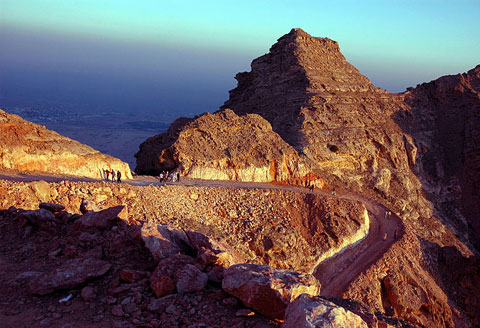
The United Arab Emirates are a group of states in the south-east of the Arabian peninsula in the Persian Gulf (Middle East). There are seven emirates: Abu Dhabi, Ajman, Dubai, Fujairah, Ras el Khaima, Sharjah and Umm al-Quwain. They border on Oman to the south-east and north and with Saudi Arabia to the west and south.
The UAE enjoys a mixed geographical terrain, comprising of a flat, arid coastal plain which inland meets the Arabian desert of Rub al-Khali. The country is mostly flat valley areas that cover more than 92% of the country, except for Al Jabal al Akhdar in the far east, which reaches 1,000 m (3,280 ft). The mountainous areas are only in the remote eastern region in the form of a north south strip with some little deviation towards the north and to the north of Alain. The highest point of UAE is Jabal Hafeet located on the outskirts of Al Ain in the Emirate of Abu Dhabi. The mountain rises 1,249 m (4,097 ft) and offers an impressive view of the city. The UAE mountains are a small part of the gigantic Omani mountains or parts within the UAE. These mountains are very close to Oman coast to the extent that there is one a narrow strip of valleys of between 5 km (3 miles) in Kalba and Ghurfa and 1 km (0.6 miles) and even less in the remaining parts of the strip to the end. The mountains' feet and its valleys fall in the sea making scenery from the east coast of the country like Ras Dibba and Sadna.
Most of the UAE is an arid desert land particularly in the inner western region that cover the rest of the country towards the coast of the Arabian Gulf and the Saudi border in the west and south. There are many famous oases in that desert region like Al-Ain oasis that utilizes the groundwater, available due to the presence of Hafit Mountain, through an irrigation network known as "Aflage". The same goes for Liwa situated 200 km (124 miles) west of Al-Ain and comprises more than 60 villages besides the rich graze land in Dhafra area that abounds in groundwater.
The UAE coast stretches for more than 650 km (403 miles) along the southern shore of the Persian Gulf. Most of the UAE coastlines are sandy except for the northern region in Ras Al Khaimah that forms the jagged mountain "Hajar". Territorial water is generally shallow, which is a feature of the Arab Gulf coastlines. The UAE territorial water abounds in fringing coral reefs that forms natural impediments to navigation. It is also rich in pearl oyster which was the main source of income for this land. There are many islands and small sandy islets including 200 islands for the emirate of Abu Dhabi the most important of which is the island of Sir Bani Yass which was made into a green haven and a natural preservative for rare animals. The largest natural harbor is at Dubai, although other ports have been dredged at Abu Dhabi, Sharjah, and elsewhere.
The culture
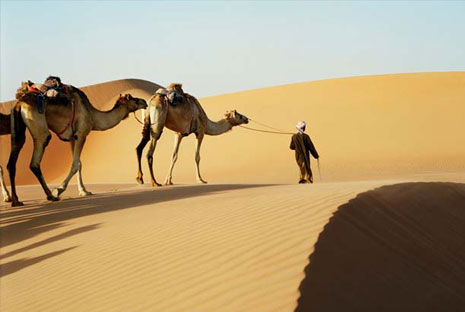
The United Arab Emirates is home to a rich cultural heritage that has been strongly influenced by the resourcefulness of its people who exploited the harsh environment of the region that included deserts, oasis, mountains and coasts. This resilience, in the face of extreme hardship, was supported by society's tribal structure, which bound the people together since successive waves of migration began over 2,500 years ago and brought Arab tribes to the region. The largest tribe, the Bani Yas, roamed the vast sandy areas that covered almost all of the emirates of Abu Dhabi and Dubai. Other tribes, such as the Awamir and Manasir, shared this challenging environment for numerous generations. All the subtribes and clans were accustomed to wander great distances with their camels in search of grazing, moving as entire family units. Almost all Bani Yas families, with the exception of the fishing groups like the Al Rumaitha returned to a home in one of the oasis settlements at certain times of year. Much prized date gardens were cultivated in the hollows of huge dunes at Liwa, tapping the water trapped beneath the absorbent sands.
Other aspects of the UAE's culture can be found by visiting places still favoured by Emirati people such as the fishing harbours or fish souqs, boat-building yards, falconry centres, gold souqs, spice souqs and other venues. Throughout the year various cultural events (exhibitions, theatrical displays, sporting events, lectures etc.) are organized by different bodies such as the Emirates Heritage Club, which runs dhow races, longboat races, camel races, and a host of other activities that encourage an interest in the UAE's heritage and culture.
Islam is the official religion and Arabic the official language of UAE. The majority of the local population is Sunni. Muslim festivals are timed according to local sightings of various phases of the moon. During the lunar month of Ramadan that precedes Eid al-Fitr, Muslims fast during the day and feast at night and normal business patterns may be interrupted. Some disruption may continue into Eid al-Fitr itself. Eid al-Fitr and Eid al-Adha may last up to several days, depending on the region. Also, the Emirati National Day is celebrated on 2nd December each year to mark the Independence Day of UAE in 1971. Schools in the UAE celebrate National Day by holding events and celebrations where kids dress up in the cultural 'thoub and "kandoora' and perform the 'Ayyalah' and 'Youlah' folk dances, as well as organize cultural contests. In Abu Dhabi, the country's capital, celebrations are held in the city's corniche in which people arrive in decorated cars marking the history of the nation. Shops also sell house decorations such as flags, to help show the people's spirit across the country.
Native menfolk of the Arabian peninsula have a distinct form of dress. They wear an ankle-length shirt (dishdasha), usually white (or colored or striped in winter), a white, or sometimes red-chequered, headcloth (ghutra) and the twisted, black rope piece (agal), holding the gutra in place. Men of distinction and the Sheikhs also wear on top of their dishdasha a flowing cloak (abba or bisht) edged with gold braid. It may he black or brown. UAE women are very particular about their dress. They generally cover themselves from head to feet with a black cloak called the 'Ahaya'.
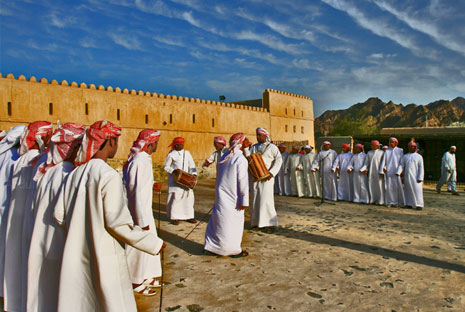
Folk dances and music are integral to any celebration. Most dances are male-oriented. Everybody present at a joyous occasion is expected to join in. Dancers sway together in a line or a circle or clapping to the accompaniment of tambourines of various sizes, with rings or bells attached. Drums are an integral part of classical and folk music. A popular dance for females has young girls in flowing black tresses swing their heads in a hypnotic, undulating movement. Many popular songs are sung on special occasion. Both music and words, usually of a bedu dialect, are simply composed. At functions attended by local dignitaries and state guests a particular folksong, the Ayyalah, is performed. Singing and brandishing camel sticks, the two lines of men advance and retreat, while the young girls encourage them by swinging their long hair. This was basically developed from a war song whose purpose was to raise the morale of the fighting men.
Countries like Morocco, Egypt, Lebanon, Tunisia and Afghanistan have influenced the culinary tradition of UAE. The most popular dish of the country is called shawarma, which is a hot sandwich with lamb or chicken served in pita bread with vegetables. Suiting the hot weather, one sees a variety of juices from mango, pineapple, banana, or mixed cocktail extensively consumed throughout the country.
Attractions & landmarks
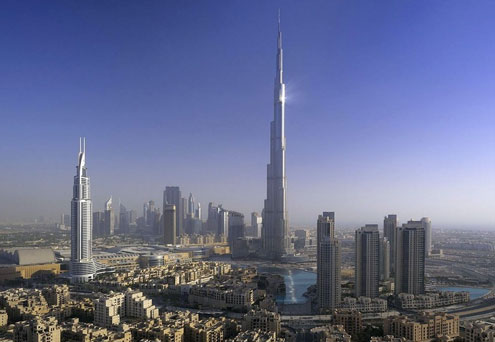
The United Arab Emirates is one of the world's fastest growing tourist destinations and has the recipe to offer a memorable vacation consisting of sun, sand, sea, sports, unbeatable shopping, top-class hotels and restaurants, an intriguing traditional culture, and a safe and welcoming environment. Though there are many natural UAE attractions found throughout the country there are also an amazing number of man-made attractions that have drawn a lot of attention to the region.
The largest natural attraction in UAE is the Rub 'al-Khali desert that can be accessed when leaving any of the major cities. The ideal areas to really enjoy the desert and have some nice panoramas is to seek the dunes which are quite common in the UAE. Leaving Dubai or Abu Dhabi in the direction of Al Ain will afford views of some dunes, spotable from the road. Many people stop here to rent a quad or a buggy or simply climb the dunes with their 4WD. The most beautiful and largest dunes in the country are in the south, near Saudi Arabia, around Liwa Oasis. The ochre sands there turn red when the sun goes down, and it forms enormous dunes, the largest of which exceed 300 m (984 ft). Desert Safaris are a very popular tour allowing visitors an unforgettable real desert safari drive adventure to traditional Arabic Bedouin campsites where camel riding, sand boarding, henna painting, sheesha and BBQ dinners can be enjoyed. There are also entertainment in the form of a traditional Arabic belly dance or tanoura dance. There aren't too many mammals that can survive the harsh desert heat but there are some that have survived well over the years including scorpions, snakes, honey badgers, gazelles, the sand cat and a strong species of fox.

The most visited city in UAE is Dubai. Since the economy is strongest in Dubai, there are always improvements being made, whether it's adding to the long list of Dubai attractions, bettering roads and highways or adding yet another shopping mall to the city's large collection. The Mall of the Emirates is a testament to the importance of shopping in the region. There are also many local souks scattered all over the country. Dubai has experienced a surge in large scale construction projects, drawing much international attention and tourism. The country is home to the world's tallest tower, Burj Khalifa. Towering over the rest of the Middle East, it stands at 829.8 m (2,722 ft). Another famous spot is the Burj al-Arab hotel, which is the only 7-star hotel in the UAE and among the world's most impressive and lavish accommodations. Near both of these incredible benchmarks of modern society are the phenomenal Palm Islands and World Islands. The new Dubai Waterfront is also under construction and sure to be another of the very famous Dubai attractions.
Even though Abu Dhabi is the capital and the hub of the UAE, it is a less popular destination than Dubai. Despite this, there are many attractions to visit. Heritage Village is one of the renowned Abu Dhabi attractions exemplifying Bedouin life through a 'living museum'. Bedouin tribes were among the first living in the deserts of the UAE and are a prevalent part of the region's history. Abu Dhabi attractions also include the revered White Fort, also known as the Al Hosn Palace. It's one of the oldest and most beautiful buildings in Abu Dhabi. It was extensively renovated in the 1980s and is now home to the Cultural Fountain, an area that features an excellent museum. The country also offers a selection of never-ending shopping malls and modern entertainment avenues, a 200 km (124 miles) coastline and numerous parks and gardens. Both the Liwa Oasis and The Corniche are also top Abu Dhabi attractions. The first is the largest Arabian oasis, home to the very hospitable Bedu tribe, many freshwater pools and date plantations. The Corniche is a coastline avenue lined with parks, palms and water that borders the city and provides a wonderful place to relax. Roller blading, long walks, picnics and more are all popular pastimes to enjoy at The Corniche.
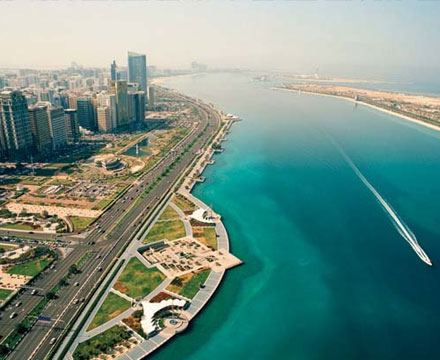
Many other UAE attractions can be explored in the revered city of Al Ain, or throughout the Persian Gulf emirates of Sharjah, Ajman, Umm Al Quwain and Ras Al Khaimah. Though most people tend to stick to Dubai, rental transportation is affordable and can take visitors further off the beaten path to discover a wealth of Arabian delights. Visitors can beach-hop and take in the sublime geography or stay at one of the excellent UAE resorts and enjoy a sun-soaked holiday. From city delights to small-town curiosities, UAE is an interesting blend of Middle Eastern culture and modern day ideals creating one of the most intriguing destinations in the Middle East today.